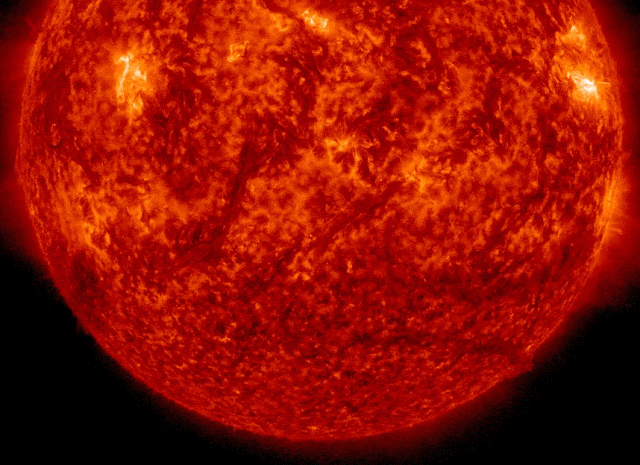During the peak of the solar cycle, as we are in for cycle 25, we tend to focus on sunspots. These cycles are regularly ranked and compared by their sunspot number, after all; the SSN or Smoothed Sunspot Number.
While sunspots are very often the source of solar weather events that affect us, those things that affect the rest of the solar system don't always come from sunspot complexes. There were two Coronal Mass Ejections from the sun this past weekend, Saturday the 12th and Sunday the 13th, that came from an area with no spots. They're visible in this photo posted at SpaceWeather.com, as nearly vertical streaks of motion and then brighter colors. They show up first slightly left of center, then slightly right of center. The first one is higher on the solar disk than the second.
Magnetic filaments are tubes of dense plasma held above the sun's surface by magnetic forces. The two pictured above are about 400,000 km long--longer than the distance between Earth and the Moon. These massive structures can erupt when their magnetic underpinnings become unstable. That happened twice in quick succession on April 12th and 13th--a rare double blast.
Fragments of the exploding filaments ripped through the sun's atmosphere to produce two CMEs, now heading for Earth. A one-two punch from these CMEs could spark a G2-class geomagnetic storm on April 16th. CME impact alerts: SMS Text.
I've been watching predictions like this more during this sunspot cycle (25)
than any cycle before now, and
I've posted about them several times. Major geomagnetic storms, not G1 or G2 as being talked about here,
but G7, 8 and above, can do substantial damage to the power grid and things
connected to the grid that are plugged in when the storm hits. That
said, my experience with Space Weather predictions is that they're less
reliable than "plain old" NOAA Earth forecasts so I tend to not go far out of
my way to watch for the storms. Watching what's happening in more or less real
time is easy to do; just
go here.
According to NOAA's forecast, the impact geomagnetic activity is expected to increase late on April 15 (1800 UTC is 2:00 PM EDT) or early April 16, peaking during the day and tapering off afterward. Timing CME impacts can be tricky, so keep with Kp, the planetary K index, your aurora alerts turned on if you have any and stay flexible — storms don't always stick to a strict schedule. This forecast is from NOAA here. This update is from 2025 UTC or 5:05PM EDT.
NOAA Kp index forecast 15 Apr - 17 Apr
Apr 15 Apr 16 Apr 17
00-03UT 1.67 4.00 4.33
03-06UT 2.33 3.00 4.33
06-09UT 2.67 5.00 4.00
09-12UT 2.33 4.00 3.67
12-15UT 2.67 6.00 4.33
15-18UT 2.00 4.00 3.00
18-21UT 3.00 5.00 2.67
21-00UT 3.67 4.33 4.00
With the highest single predicted Kp at 6.0 on Wednesday morning at 8 to 11AM (EDT), this doesn't look to be
dangerous, but could be fun for ham propagation on the highest HF bands
and the 6m VHF band.

So I shouldn't run into the street screaming, "We're all going to die!"?
ReplyDeleteNo, us regular folk seem to go about our business in regular fashion regardless, we have become accustomed to so much being done to us, like constant DEW's employed against do manu targeted individuals, the collateral effects effect many more. A couple CME's? Meh. Hardly nothing... But, I do believe it is the crazy oligarchy running things, slip into extra crazy mode, anecdotal sure, yet once you see what kind of crazy they are you cannot unsee it. I mean they are already mentally unstable, does not take much to nudge them into their insanity modes.
DeleteI should have put up higher that it looks more like a better time to play on the radio than to hide under your bed.
DeleteThese G1 or 2 (or 3...) storms get a lot of attention from hams who want to see, "how far can you talk on that thing?"
Here in Florida, it's much easier to talk with guys at the southern end of South America on the VHF band than to good sized cities up in Minnesota.
Oooooh! Pretty lights in the sky............
ReplyDeleteSo it looks like it got here early, around 1800 UTC yesterday, and appears to be over. I don't think it's possible to know if that was the first one, both of them, or they turned into a "cannibal CME" and merged so we only get the one. Guess we'll know by tomorrow.
DeleteWell, the 1200-1500 UTC Kp (8 AM to Noon EDT) is 7.33 and we're in a G2 geomagnetic storm. Pretty much as predicted - that clip above said 6 for 12-15 UTC. Since what they report is an average, there's a few ways you can average three integers in the range of 1 to about 10 for the Kp and get 7.33, but it's kind of silly to just guess what they were.
Delete